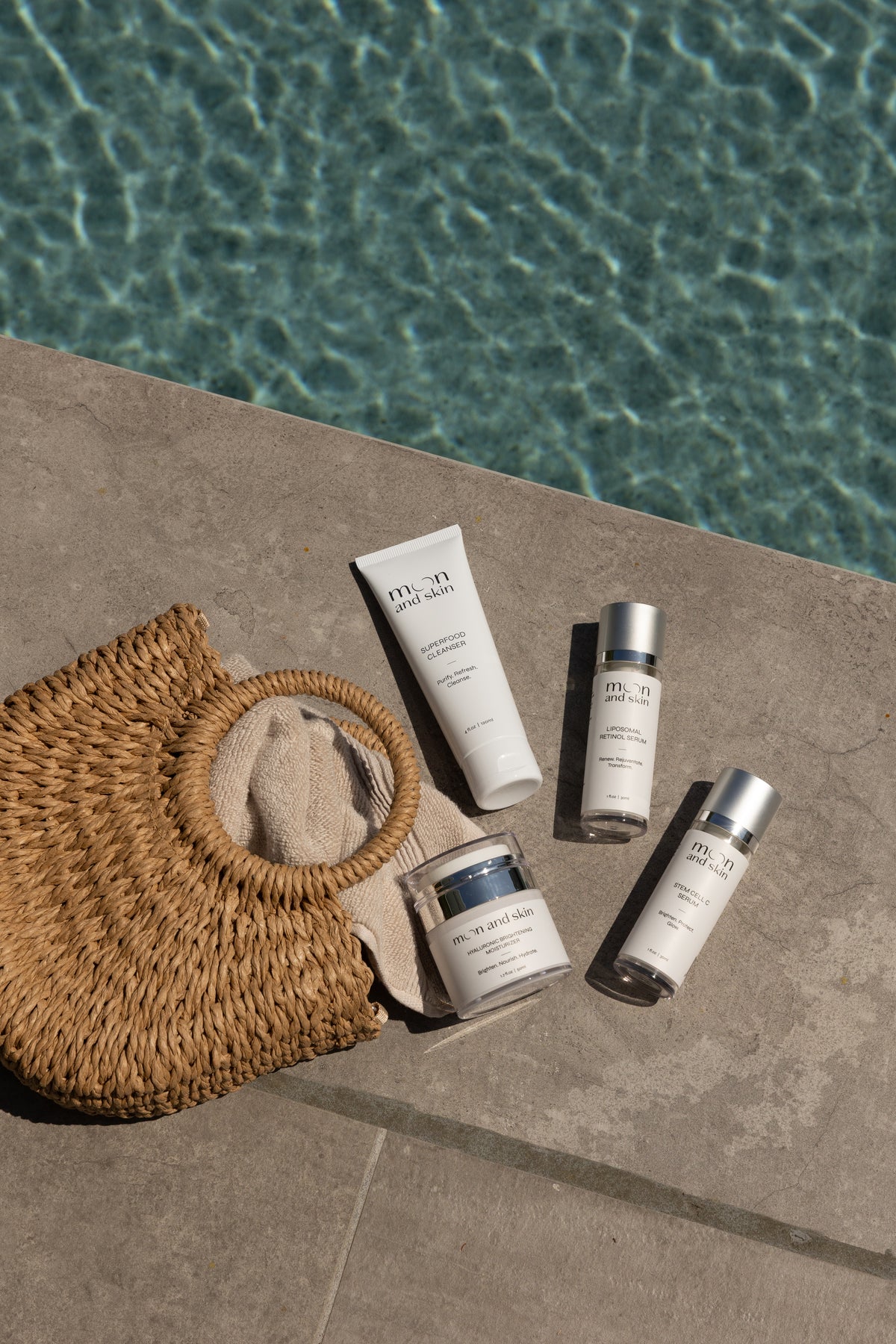Table of Contents
Introduction
Navigating the world of skincare can feel overwhelming, especially when it comes to understanding the proper order of application for your products. Did you know that applying your skincare in the wrong order could hinder the effectiveness of those carefully formulated serums and treatments? According to dermatologists, the sequence in which you apply your products matters significantly. It can mean the difference between glowing skin and lackluster results.
At Moon and Skin, we understand that every individual's skin tells a unique story, evolving with time and circumstances. This guide is designed to unravel the complexities of skincare routines, helping you achieve your skin goals with confidence. We’ll explore the essentials of proper layering, delve into the specific benefits of each product, and offer insights on how our thoughtfully crafted products—like our Stem Cell C Serum—can fit seamlessly into your routine.
With a focus on clean, effective formulations, we’re here to empower you to celebrate your skin at every phase of life. Let’s break down the steps to ensure you’re maximizing the benefits of your skincare routine.
Understanding Your Skin Type
Before we dive into the order of application, it’s crucial to recognize that the best skincare routine is tailored to your individual skin type. Here’s a brief overview of common skin types:
- Oily Skin: Characterized by excess oil production, larger pores, and a tendency to break out. Look for lightweight, oil-free products.
- Dry Skin: Often feels tight, rough, or flaky. Seek out rich moisturizers and hydrating ingredients.
- Combination Skin: A mix of oily and dry areas, often with an oily T-zone (forehead, nose, chin) and dry cheeks. Balance is key with this type.
- Sensitive Skin: Prone to redness, irritation, and allergic reactions. Gentle, fragrance-free formulations are best.
- Normal Skin: Neither too oily nor too dry, this skin type is generally well-balanced.
Identifying your skin type will help you select products that address your specific concerns effectively. As we proceed, we’ll offer tips on how our Hyaluronic Brightening Moisturizer and other products can support your unique needs.
The Importance of Product Order
The order in which you apply your skincare products significantly impacts their effectiveness. Most experts agree on a fundamental principle: apply products from thinnest to thickest. This allows lighter formulations to penetrate the skin without being blocked by heavier products.
Why Does Order Matter?
- Absorption: Lighter products like serums need to be applied first to ensure they are absorbed into the skin.
- Efficacy: Certain active ingredients require specific conditions to work optimally. For instance, retinol should be applied after serums but before heavier creams.
- Prevention of Occlusion: Applying heavier products first can create a barrier that prevents lighter products from penetrating the skin.
Let’s explore the recommended order of application for both morning and evening routines.
Morning Skincare Routine
Your morning skincare routine should focus on protection and preparation for the day ahead. Here’s a step-by-step breakdown:
Step 1: Cleanser
Start with a gentle cleanser to remove any overnight oil and impurities. For optimal results, we recommend using our Superfood Cleanser, which is formulated to nourish while effectively cleansing.
Key Takeaway: Cleansing your skin prepares it for the absorption of subsequent products.
Step 2: Toner (Optional)
Toners can help balance the skin’s pH and remove any residual impurities. Choose a hydrating toner if you have dry or sensitive skin, or an astringent if you have oily skin.
Tip: If you choose to use a toner, apply it immediately after cleansing.
Step 3: Antioxidant Serum
Next, apply an antioxidant serum. Our Stem Cell C Serum is an excellent choice, as it contains stable vitamin C to brighten your complexion and protect against environmental stressors.
Key Takeaway: Antioxidants protect your skin from damage caused by free radicals, promoting a healthier appearance.
Step 4: Spot Treatment
If you have specific blemishes or dark spots, apply a targeted spot treatment at this stage. Make sure to apply it directly onto the areas of concern.
Tip: Allow the spot treatment to dry completely before moving on to the next step.
Step 5: Eye Cream
Apply a lightweight eye cream next. The skin around your eyes is delicate and requires special care. Use your ring finger to gently tap the product around your orbital bone.
Key Takeaway: Eye creams can help address puffiness, dark circles, and fine lines.
Step 6: Moisturizer
Follow with a moisturizer to hydrate and lock in moisture. Our Hyaluronic Brightening Moisturizer is perfect for this step, providing hydration while being acne-safe.
Key Takeaway: Moisturizers help maintain the skin's moisture barrier, keeping it soft and supple.
Step 7: Sunscreen
Finally, finish your morning routine with a broad-spectrum sunscreen of SPF 30 or higher. Sunscreen is essential for protecting against UV damage and preventing premature aging.
Tip: Apply sunscreen generously to all exposed areas and reapply every two hours when outdoors.
Evening Skincare Routine
Your evening routine should focus on repairing and rejuvenating your skin overnight. Here’s how to structure it:
Step 1: Makeup Remover (If Necessary)
If you wear makeup, start with an oil-based makeup remover to dissolve any products. This step is crucial for ensuring your skin is completely clean before cleansing.
Step 2: Cleanser
Follow with a gentle cleanser, again using our Superfood Cleanser to remove any residual makeup and impurities.
Step 3: Exfoliant (2-3 Times a Week)
In the evening, consider incorporating an exfoliant into your routine 2-3 times a week to slough off dead skin cells. This will help improve skin texture and promote a brighter complexion.
Step 4: Hydrating Mist or Toner
As with your morning routine, you can apply a hydrating mist or toner to prep your skin for the next steps.
Step 5: Serums and Essences
Apply your serums next, focusing on your skin's specific needs. If you’re using retinol, apply it here as the active ingredients can be potent and are best used before heavier products.
Tip: Wait a few minutes for the serum to absorb fully into the skin.
Step 6: Eye Cream
Reapply your eye cream to nourish the delicate area around your eyes overnight.
Step 7: Moisturizer
As in your morning routine, follow with a moisturizer to lock in hydration. This step is essential for maintaining your skin’s moisture levels while you sleep.
Step 8: Face Oils (Optional)
If your skin is particularly dry, you may choose to add a face oil to seal in moisture. Apply it as the final step in your routine.
Key Takeaway: Applying oils last helps lock in moisture and nutrients from previous products.
Special Considerations for Different Skin Types
Oily Skin
If you have oily skin, focus on lightweight, non-comedogenic products. You may skip heavier oils and opt for gel-based moisturizers instead.
Dry Skin
For dry skin, choose creamier cleansers and heavier moisturizers. Incorporating hydrating serums can also be beneficial.
Sensitive Skin
If you have sensitive skin, avoid alcohol-based toners and opt for fragrance-free, soothing ingredients to minimize irritation.
FAQs
Q: Can I use multiple serums? A: Yes, but layer them from thinnest to thickest. Consider using a hydrating serum in the morning and an anti-aging serum at night.
Q: What if I have a busy morning and can’t do all the steps? A: Prioritize cleansing, moisturizing, and sunscreen. You can always add in other steps when you have more time.
Q: How often should I exfoliate? A: Exfoliate 2-3 times a week, depending on your skin type and sensitivity.
Q: Is it necessary to use a separate eye cream? A: While not absolutely necessary, eye creams are formulated specifically for the delicate skin around the eyes and can offer additional benefits.
Conclusion
Understanding the order of your skincare routine is essential for maximizing the benefits of your products. By applying products from thinnest to thickest, you ensure that each ingredient can penetrate the skin effectively. We at Moon and Skin believe in empowering you to create a routine that not only caters to your unique skin needs but also celebrates the journey of your skin.
Ready to elevate your skincare routine? Explore our Bundle & Save collection and discover how our core products, including the Liposomal Retinol Serum and Hyaluronic Brightening Moisturizer, can work together to enhance your skincare experience. Let’s embark on this journey to beautiful skin together!







